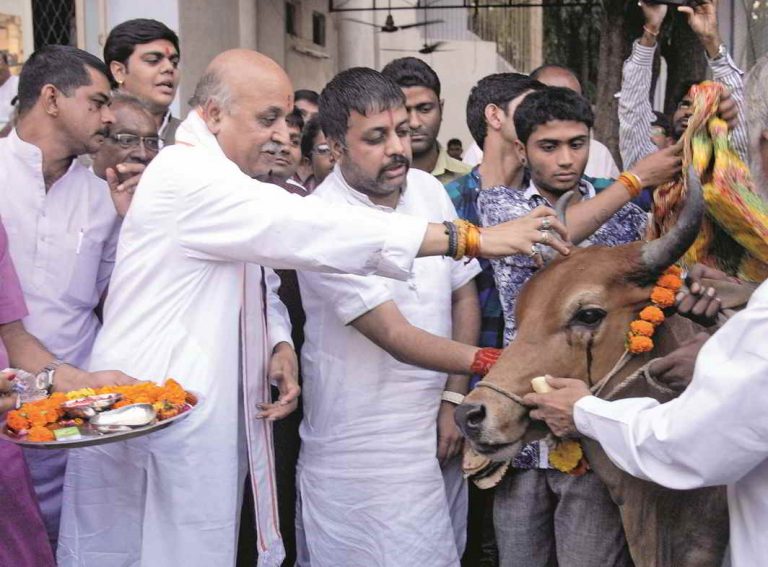
Most states have legislation in place to tackle cow slaughter and they were all made before the BJP came to power in 2014

~By Parsa Venkateshwar Rao Jr
Excepting Meghalaya and Nagaland, all other states and Union Territories have an anti-cow slaughter law in place. In some states, it is specifically called Prohibition or Prevention of Cow-slaughter Act, in others, it is called Animal Preservation Act, while in still others, the term used is Agricultural Cattle Act.
In Punjab, it is called the Punjab Prohibition of Cow Slaughter Act, 1955, and in Uttar Pradesh, it is the Uttar Pradesh Prevention of Cow Slaughter Act, 1955. In Maharashtra, it is the Maharashtra Animal Preservation Act, 1976, which was originally enacted in 1954. In Madhya Pradesh, it is the Madhya Pradesh Agricultural Cattle Preservation Act, 1959, while in Kerala, it is panchayats which impose restrictions on the killing of cows and regulate that of other animals. There is no central legislation on the issue.
” font_container=”tag:p|font_size:20px|text_align:left|color:%23000000″ google_fonts=”font_family:Open%20Sans%3A300%2C300italic%2Cregular%2Citalic%2C600%2C600italic%2C700%2C700italic%2C800%2C800italic|font_style:700%20bold%20regular%3A700%3Anormal”]
Ban on cow-slaughter is not exactly the preserve of the BJP or Hindutva groups alone. Most of the state legislations were put in place in the 1950s, 1960s and 1970s. There is little doubt that chief ministers in the BJP-ruled states of Gujarat, Madhya Pradesh and Chhattisgarh are only too keen to ride the bandwagon of ban on cow-slaughter and derive political mileage out of it. For example, Gujarat has passed an amendment to the Gujarat Animal Preservation Act on March 31 where punishment for cow-slaughter has been made stringent by making the term of imprisonment 14 years, which is the norm for a life-term.
The government may succeed because not many are going to look for anti-cow slaughter laws and when they were legislated. It has also become evident that cow vigilantes across north India are on the rampage despite Prime Minister Narendra Modi’s mild rebuke to those who took law into their hands while praising the work of gau-rakshaks.
The public debate in metropolitan India, which is mainly confined to the English language media, seems to be focused on issues such as personal choice and dietary preferences, all tied up with the individual. This will remain a knee-jerk response unless attention is paid to the arguments, restrictions and rules in various anti-cow slaughter legislations.
Very few of these laws address the issue directly and without ambiguity. For example, the Uttar Pradesh Prevention of Cow Slaughter Act, 1955, Section 2, Definitions Note, says: “… (a) ‘beef’ means flesh of cow but does not include such flesh contained in sealed containers and imported as such into Uttar Pradesh”, and the Note for Section 5 of the Act says: “This section makes it illegal to transport or sell any beef or beef product in any form except for medical purposes specifically permitted by state authorities. However, the exception legally permitted is where a person sells or serves beef or beef products to passengers on aircrafts or trains.”
The Uttar Pradesh Act allows for the killing of cows if they are suffering from contagious disease and for the sake of experimentation in public interest. The Note explaining Section 4 of the Act says: “This section carves out exceptions where it will be permissible to slaughter cows which have infectious diseases or cows which are certified necessary for slaughter by the State Government in the interest of research for public purposes.” In a 2002 amendment to the Act, the Statement of Objects and Reasons said: “In the said Act (of 1955) the slaughter of bull and bullock is prohibited only up to a particular age. As the number of bulls and bullocks is consistently decreasing in the State, it has been decided to impose complete prohibition on the slaughter thereof in order to preserve these species by amending the said Act.”
Ban on cow-slaughter is not the preserve of the BJP or Hinduvta groups… However, the CMs in BJP-ruled states like to ride the bandwagon for political mileage.
The Madhya Pradesh Preservation of Agricultural Cattle Preservation Act allows for the slaughter of agricultural cattle other than cows, calves of cow or calves of she-buffaloes, but the following conditions have to be met through a veterinary officer’s certification that “(a) the cattle is over 20 years of age and is unfit for work or breeding or has become permanently incapacitated from work or breeding due to age, injury, deformity of an incurable disease; and (b) the cattle are not suffering from any incurable disease, which makes meat unwholesome for human consumption.”
A 1994 amendment to the Gujarat Preservation of Animals Act prohibited the killing of cows’ progeny, including bulls and bullocks. It was challenged, and a seven-judge constitutional bench of the Supreme Court comprising then Chief Justice of India RC Lahoti and Justices BN Agrawal, Arun Kumar, GP Mathur, CK Thakker and PK Balasubramanyan on October 26, 2005. It upheld the amendment made by the Gujarat government and overturned the High Court verdict that the amendment imposed unreasonable restrictions on a section of the people.
The Supreme Court in 2005 concurred with the Preamble of the Ordinance which preceded the amendment of 1994. The Court quoted the Preamble, which said among other things: “Whereas it is established that cow and her progeny sustain the health of the nation by giving them the life-giving milk which is so essential an item in a scientifically-balanced diet; And whereas the working bullocks are indispensable for our agriculture for they supply power more than any other animal; And whereas the working bullocks are often useful in ploughing the fields, drawal of water from the wells and also very useful for drawing carts for transporting grains and fodder from the fields to the residences of farmers as well as to the Agricultural Market Yard…”
The chief minister of Gujarat at the time was Chhabildas Mehta, who succeeded Chimanbhai Patel. The governor at the time was Dr Sarup Singh, who was appointed by the VP Singh government. The Bench also cited a 1995 verdict of the Supreme Court in The State of West Bengal and Others v Ashutosh Lahiri which held that the restrictions imposed on the butchers were reasonable.
The BJP is certainly going to play up the emotive issue of protection of the cow in all state assemblies and the 2019 Lok Sabha elections to take political advantage. But the more crucial fact is the law that is in place in different states and the Supreme Court’s own considered view.
It leaves the opponents of cow protection in a vulnerable position.

